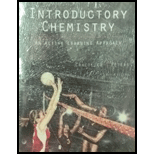
Concept explainers
(a)
Interpretation:
The solution with
Concept introduction:
The
Answer to Problem 43E
The given solution is neutral in nature.
Explanation of Solution
The
| Strongly acidic | |
| Weakly acidic | |
| Neutral | |
| Weakly basic | |
| Strongly basic |
The
Therefore, the given solution is neutral.
The nature of the given solution is neutral.
(b)
Interpretation:
The solution with
Concept introduction:
The
Answer to Problem 43E
The nature of the given solution is weakly basic.
Explanation of Solution
The
| Strongly acidic | |
| Weakly acidic | |
| Neutral | |
| Weakly basic | |
| Strongly basic |
Therefore, the given solution is weakly basic in nature.
The nature of the given solution is weakly basic.
(c)
Interpretation:
The solution with
Concept introduction:
The
Answer to Problem 43E
The nature of the given solution is strongly basic in nature.
Explanation of Solution
The value of
The formula to calculate
Rearrange the above equation.
Substitute the value of
The
| Strongly acidic | |
| Weakly acidic | |
| Neutral | |
| Weakly basic | |
| Strongly basic |
Therefore,
Hence, the solution is strongly basic in nature.
The solution is strongly basic in nature.
Want to see more full solutions like this?
Chapter 17 Solutions
Bundle: Introductory Chemistry: An Active Learning Approach, 6th + LMS Integrated for OWLv2, 4 terms (24 months) Printed Access Card
- Write equations that show H2PO4- acting both as an acid and as a base.arrow_forwardWhich of the following substances are acids in terms of the Arrhenius concept? Which are bases? Show the acid or base character by using chemical equations. a P4O10 b Na2O c N2H4 d H2Tearrow_forwardUsing the diagrams shown in Problem 10-37, which of the four acids is the weakest acid?arrow_forward
- Consider the following four solutions: (1) apple juice, pH 3.8, (2) pickle juice, pH 3.5, (3) carbonated beverage, pH 3.0, and (4) drinking water, pH 7.2. a. Which solution has the highest [H3O+]? b. Which solution has the highest [OH]? c. List the solutions in order of increasing acidity. d. List the solutions in order of decreasing basicity.arrow_forwardPure liquid ammonia ionizes in a manner similar to that of water. (a) Write the equilibrium for the autoionization of liquid ammonia. (b) Identify the conjugate acid form and the base form of the solvent. (c) Is NaNH2 an acid or a base in this solvent? (d) Is ammonium bromide an acid or a base in this solvent?arrow_forwardDifferentiate between the terms strength and concentration as they apply to acids and bases. When is HCl strong? Weak? Concentrated? Dilute? Answer the same questions for ammonia. Is the conjugate base of a weak acid a strong base?arrow_forward
- Indicate whether each of the following samples is acidic, basic, or neutral. a. butter, pH 6.1 b. lemon juice, pH 2.2 c. peach, pH 3.5 d. milk of magnesia, pH 10.5arrow_forwardWill the following oxides give acidic, basic, or neutral solutions when dissolved in water? Write reactions to justify your answers. a. CaO b. SO2 c. Cl2Oarrow_forward
 Introductory Chemistry: An Active Learning Approa...ChemistryISBN:9781305079250Author:Mark S. Cracolice, Ed PetersPublisher:Cengage Learning
Introductory Chemistry: An Active Learning Approa...ChemistryISBN:9781305079250Author:Mark S. Cracolice, Ed PetersPublisher:Cengage Learning Chemistry: Principles and PracticeChemistryISBN:9780534420123Author:Daniel L. Reger, Scott R. Goode, David W. Ball, Edward MercerPublisher:Cengage Learning
Chemistry: Principles and PracticeChemistryISBN:9780534420123Author:Daniel L. Reger, Scott R. Goode, David W. Ball, Edward MercerPublisher:Cengage Learning General Chemistry - Standalone book (MindTap Cour...ChemistryISBN:9781305580343Author:Steven D. Gammon, Ebbing, Darrell Ebbing, Steven D., Darrell; Gammon, Darrell Ebbing; Steven D. Gammon, Darrell D.; Gammon, Ebbing; Steven D. Gammon; DarrellPublisher:Cengage Learning
General Chemistry - Standalone book (MindTap Cour...ChemistryISBN:9781305580343Author:Steven D. Gammon, Ebbing, Darrell Ebbing, Steven D., Darrell; Gammon, Darrell Ebbing; Steven D. Gammon, Darrell D.; Gammon, Ebbing; Steven D. Gammon; DarrellPublisher:Cengage Learning General, Organic, and Biological ChemistryChemistryISBN:9781285853918Author:H. Stephen StokerPublisher:Cengage Learning
General, Organic, and Biological ChemistryChemistryISBN:9781285853918Author:H. Stephen StokerPublisher:Cengage Learning Chemistry: An Atoms First ApproachChemistryISBN:9781305079243Author:Steven S. Zumdahl, Susan A. ZumdahlPublisher:Cengage Learning
Chemistry: An Atoms First ApproachChemistryISBN:9781305079243Author:Steven S. Zumdahl, Susan A. ZumdahlPublisher:Cengage Learning





